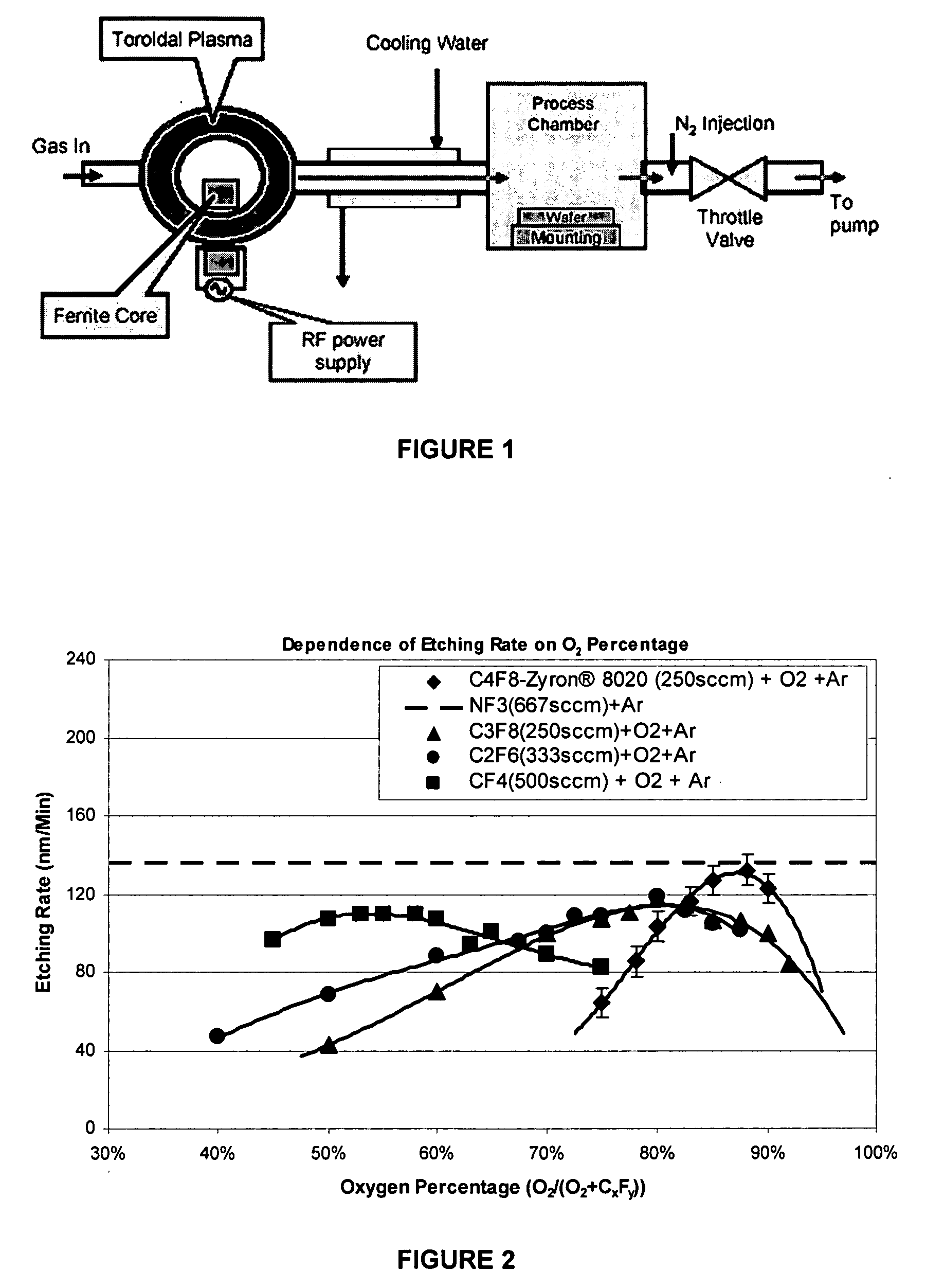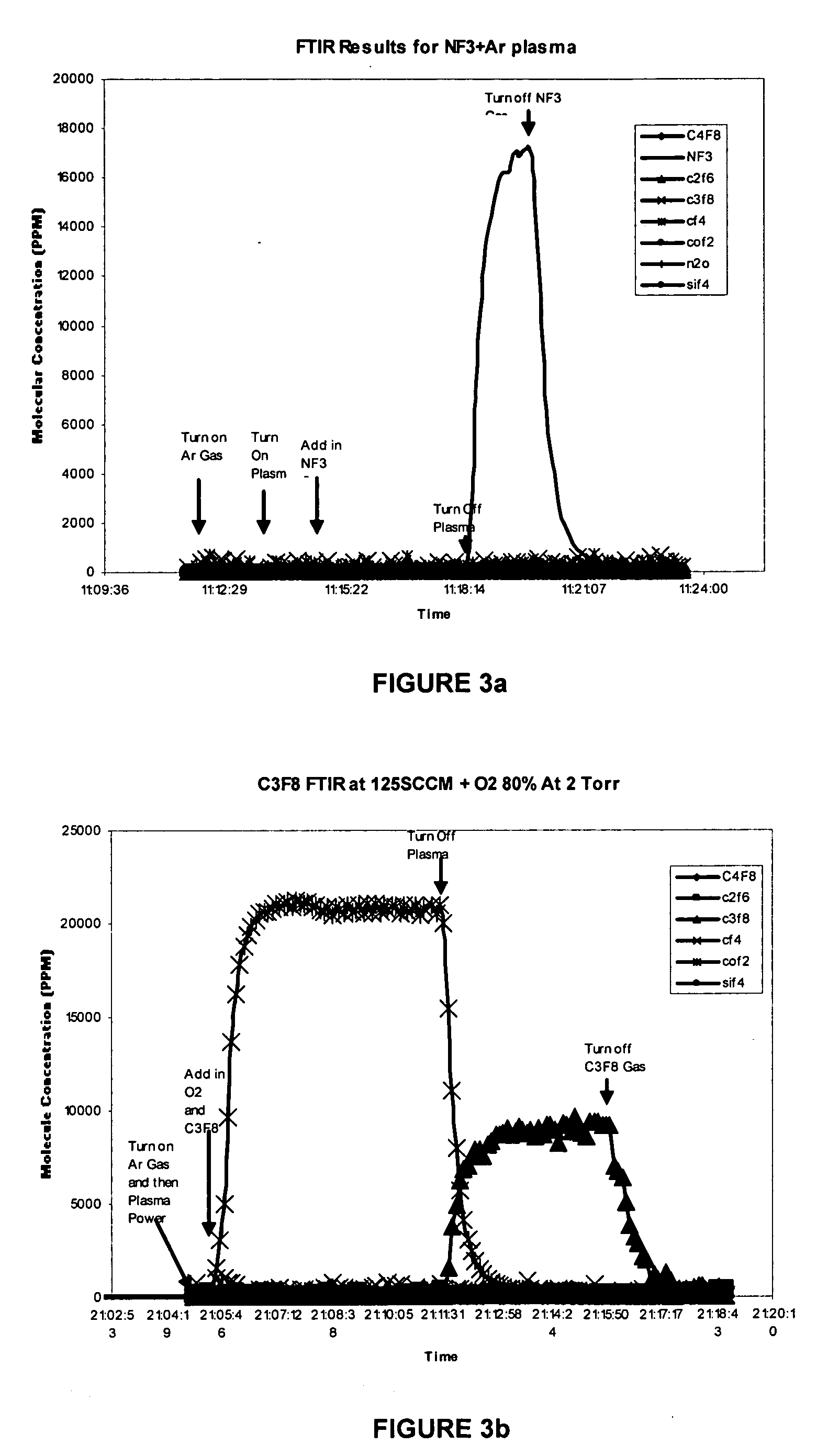Remote chamber methods for removing surface deposits
a technology of surface deposits and remote chambers, applied in the direction of coatings, decorative arts, chemical vapor deposition coatings, etc., can solve the problems of pecvd equipment manufacturers
- Summary
- Abstract
- Description
- Claims
- Application Information
AI Technical Summary
Benefits of technology
Problems solved by technology
Method used
Image
Examples
example 1
[0028] The feeding gas composed of O2, perfluorocarbon and Ar, wherein the perfluorocarbon is Zyron® 8020 (C4F8), C3F8, C2F6, or CF4. The flow rates of perfluorocarbons in this Example were adjusted so that the molar flow rate of elemental fluorine into the remote chamber was the same for all mixtures. In this Example, the flow rates for C4F8, C3F8, C2F6, and CF4 were 250, 250, 333 and 500 sccm respectively, which are all equivalent to 2000 sccm of elemental fluorine. The percentage flow rate of O2 to the total of O2 and perfluorocarbon was changed to detect the etching rate dependence on the O2 percentage. See FIG. 2. The total feeding gas flow rate was fixed at 4000 sccm by adjusting argon flow. Nitrogen was added between the process chamber and the pump at a flow rate of 20,000 sccm. Chamber pressure is 2 torr. The feeding gas was activated by 400 KHz RF power to a neutral temperature of more than 5000 K. The activated gas then entered the process chamber and etched the SiO2 surf...
example 2
[0031] The common experimental conditions for FIGS. 3a, 3b, 3c and 3d are described in the following paragraph below.
[0032] Chamber pressure was 2 torr. The feeding gas was activated by 400 KHz RF power to a neutral temperature of more than 3000 K for NF3 gas mixture and more than 5000K for perfluorocarbon gas mixtures. The activated gas then entered the process chamber and etched the SiO2 surface deposits on the mounting with the temperature controlled at 100° C. FTIR was used to measure the concentration of emission species in the pump exhaust.
[0033] As for FIG. 3a, the feeding gas composed of NF3 and Argon with flow rates of 333 sccm and 3667 sccm respectively.
[0034] As for FIG. 3b, the feeding gas composed of 125 sccm of C3F8, 500 sccm of O2 and 3375 sccm of Argon.
[0035] As for FIG. 3c, the feeding gas composed of 125 sccm of C4F8, 1125 sccm of O2 and 2750 sccm of Argon.
[0036] As for FIG. 3d, the feeding gas composed of 250 sccm of CF4, 306 sccm of O2 and 3444 sccm of Argon...
example 3
[0039]FIGS. 4a and 4b demonstrate the effects of perfluorocarbon flow rate and O2 percentage (O2 / (CxFy+O2)) on the concentration of emission gases. For both Figures, from left to right the bars in each group indicate emission concentrations of C4F8, C2F6, C3F8, CF4 and COF2. For the experiments of FIG. 4a, the C4F8 flow rates was 93.75 sccm, 125 sccm, 187.5 sccm or 250 sccm, as shown at axis X of the Figure. The corresponding O2 flow rates are 656, 875, 1313 and 1750 sccm, respectively. The total feeding gas flow rate was fixed at 4000 sccm by adjusting Argon flow. Chamber pressure was 2 torr. The feeding gas was activated by 400 KHz RF power to a neutral temperature of more than 5000 K. The activated gas then entered the process chamber and etched the SiO2 surface deposits on the mounting with the temperature controlled at 100° C. FTIR was used to measure the concentration of emission species in the pump exhaust.
[0040] For the experiments of FIG. 4b, the C4F8 flow rates was 250 sc...
PUM
| Property | Measurement | Unit |
|---|---|---|
| temperature | aaaaa | aaaaa |
| pressure | aaaaa | aaaaa |
| pressure | aaaaa | aaaaa |
Abstract
Description
Claims
Application Information
 Login to View More
Login to View More - R&D
- Intellectual Property
- Life Sciences
- Materials
- Tech Scout
- Unparalleled Data Quality
- Higher Quality Content
- 60% Fewer Hallucinations
Browse by: Latest US Patents, China's latest patents, Technical Efficacy Thesaurus, Application Domain, Technology Topic, Popular Technical Reports.
© 2025 PatSnap. All rights reserved.Legal|Privacy policy|Modern Slavery Act Transparency Statement|Sitemap|About US| Contact US: help@patsnap.com



